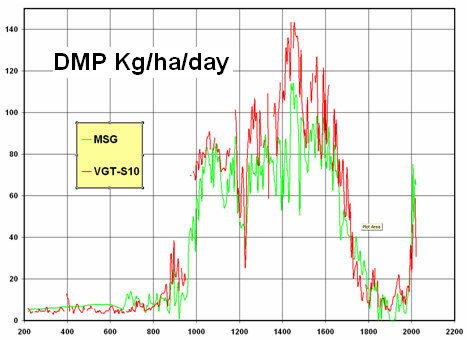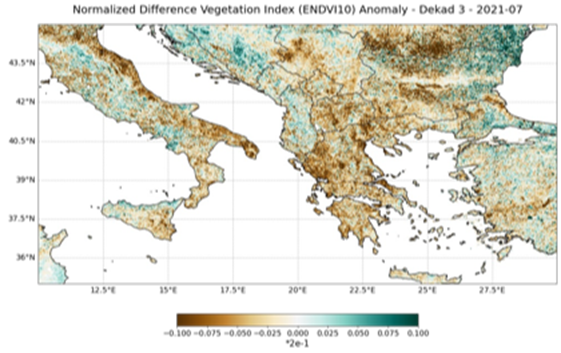5.9 - Further Applications of LSA SAF Vegetation Products
In this section we will show how vegetation products can be used for a wide range of land biosphere applications that are directly related to vegetation properties and health.
5.9.1 - Estimation of Vegetation productivity
Vegetation productivity along the Kalahari transect:
The Kalahari Transect (KT), is one of the International Geosphere-Biosphere Programme (IGBP) (accessed in 2010) proposed Transects.
It spans a strong climatic gradient in southern Africa, from the arid south to the humid north, while remaining on a single broad soil type, the deep sands of the Kalahari basin.The vegetation ranges over the length of the transect from shrubland through savannas and woodlands to closed evergreen tropical forest, with land uses ranging from migratory wildlife systems, through pastoralism, subsistence cropping to forestry.
The aim to define this transect was to:
- integrate ongoing and future biophysical and relevant socio-economic work in the Kalahari eco-region;
- to enhance understanding of the entire system within the context of human and climatically induced environmental change.
5.9.2 - Dry Matter Productivity
Dry Matter Productivity (DMP) is the increase in dry matter biomass. Its estimation is useful for:
- Crop monitoring;
- Yield forecasting;
- Carbon sequestration / Net Primary Productivity (NPP)
The Joint Research Center (JRC) is computing this parameter following the approach proposed by Monteith (1972) (LSA SAF 3rd User Training Workshop), in which DMP is a function of the:
- Incoming solar radiation (0.2-3.0 μm);
- Surface Temperature;
- fAPAR
Next figure shows the comparison between DMP as estimated by JRC, based on fAPAR from SPOT and MSG, in a north-south transect through Africa along the 20 °E meridian, from Lybia (left of the graphic) to Cape Town (right of the graphic). The example is for the 3rd decade of February 2008 and shows very good spatial consistency between the two estimated fields.
5.9.3 - Drought Monitoring
DROUGHT OVER EUROPE
The 2021 Summer was very warm and several regions, such as the eastern Mediterranean area, were also affected by drought conditions. In late July, a strong 'blocking high' pressure system was formed over southeastern parts of Europe, increasing dry conditions and causing an intense heatwave with exceptionally high temperatures initially across the eastern and central Mediterranean areas and the Balkans. Satellite observation revealed that vegetation is under stress conditions, presenting lower greenness (NDVI) than usual (brown regions).
https://fire.trainhub.eumetsat.int/docs/figure1_LSA_SAF_NDVI.html

